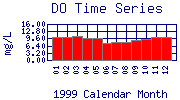 |
|
 |
|
DISSOLVED OXYGEN
It is difficult to compare dissolved oxygen (DO) concentrations between the sampling sites because of the drastic change in elevation in the Boulder Creek Watershed (from 8240 feet above sea level (asl) at the Lakewood Reservoir on North Boulder Creek to 4955 feet asl at the confluence of Coal Creek and Boulder Creek). Elevation affects DO concentrations because there is greater atmospheric pressure at lower elevations, and this increases the maximum amount of DO the water can hold. The DO content is also affected by temperature; dissolved oxygen (DO) increases as temperature decreases. The temperature of Boulder Creek can vary drastically from the mountain sites to the plain sites.
 In sample sites on upper Boulder Creek (mountain and canyon sites), the concentration of dissolved oxygen (DO) is controlled by temperature; the DO concentration at each site increases as
temperature decreases. Therefore, sample sites in upper Boulder Creek have
higher DO values in winter than summer (for example, see North Boulder Creek at Lakewood Reservoir).
In sample sites on upper Boulder Creek (mountain and canyon sites), the concentration of dissolved oxygen (DO) is controlled by temperature; the DO concentration at each site increases as
temperature decreases. Therefore, sample sites in upper Boulder Creek have
higher DO values in winter than summer (for example, see North Boulder Creek at Lakewood Reservoir).
Farther downstream, several factors affect DO concentrations in Boulder Creek as it leaves the city of Boulder and travels across the plains. DO values in Boulder Creek drop significantly at
75th Street, which is just downstream of where effluent from the City of
Boulder’s Wastewater Treatment Plant (WWTP) enters the Creek (see for example
February, 1999).
 The effluent contributes organic waste and nutrients, which encourage the growth of bacteria. These bacteria consume the waste and remove oxygen from the water.
The effluent contributes organic waste and nutrients, which encourage the growth of bacteria. These bacteria consume the waste and remove oxygen from the water.
Farther downstream, DO levels are affected in a different way by the WWTP effluent. Nutrients in the effluent and from fertilizer runoff (which contributes nitrogen and phosphorus) feed aquatic plants in the creek, allowing significant growth to occur. The plant growth is further encouraged by the high amount of sunlight that reaches Boulder Creek, due to little riparian vegetation shading lower Boulder Creek. This increase in plant growth produces a much larger amount of oxygen during the day as photosynthesis occurs. Monthly water samples by the City of Boulder are collected during the day; therefore, the samples from lower Boulder Creek reflect these high DO levels. However, during night time, the plants are not photosynthesizing, but are respiring, and they (along with bacteria and aquatic animals) consume oxygen and release carbon dioxide. This causes DO levels to drop significantly at night. The magnitude of the difference from night and day is affected by the season. During the summer, plants are exposed to sunlight for a much longer time, so they are growing faster, and the DO levels show the greatest variation at this time. More information on the daily variation of DO downstream of the WWTP can be found here.

COMPARISON TO REGULATIONS
Colorado Department of Public Health and Environment Water Quality Control Division (CDPHE-WQCD) Regulations state that the minimum DO concentration for waters to be used for domestic water supply or for recreation (both primary and secondary contact) is 3 mg/L. All DO concentrations reported for North Boulder Creek/Boulder Creek during 1998 - 2000 were greater than 3 mg/L.
CDPHE-WQCD regulations state that waters classifed as "Class 1 Cold Water Aquatic Life" should never have DO concentrations below 6.0 mg/L. Upstream of the confluence of South Boulder Creek and Boulder Creek, Boulder Creek is classified as a Class 1 Cold Water stream. All samples collected from 1998 - 2000 from this reach of the creek had DO concentrations above 6.0 mg/L.
CDPHE-WQCD regulations state that waters classified as "Class 1 Warm Water Aquatic Life" should never have DO concentrations below 5.0 mg/L. Downstream of South Boulder Creek, Boulder Creek is classified as a Class 1 Warm Water stream. All but one sample collected from 1998 - 2000 had concentrations above 5.0 mg/L.